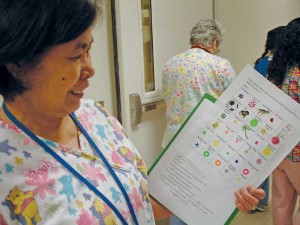Preparation Pays for Hopkins Nurses
by Elizabeth Heubeck
![]() Almost a decade ago, before blueprints were completed and walls erected for the Sheikh Zayed Tower and The Charlotte R. Bloomberg Children’s Center, The Johns Hopkins Hospital’s (JHH) leaders gave nurse managers the go-ahead to begin planning.
Almost a decade ago, before blueprints were completed and walls erected for the Sheikh Zayed Tower and The Charlotte R. Bloomberg Children’s Center, The Johns Hopkins Hospital’s (JHH) leaders gave nurse managers the go-ahead to begin planning.
“We were told to start piloting new processes before the move,” recalls Joan Diamond, MS, RN, NEA-BC, prenatal nurse manager and a member of JHH’s Transition Monitoring Team, a team created to help guide nurses through the transition to the new building. The charge was intended to jumpstart preparations for the JHH nurses—more than 2,800—who would be affected, either directly or indirectly, by the spring 2012 opening of the new building.
Since then, nurse managers have worked relentlessly to ensure their nurses feel a sense of control over their new situation. After absorbing recommendations by consultants with expertise in hospital moves and implementing a renowned training program called “Managing Organizational Transition,” which seeks to empower employees confronting change, nurse managers got to work.

“We expect everything to be up and running before the first patient is admitted to the building. We simulated everything ahead of time,” Diamond says. In some cases, nurses practiced new models of care well in advance of the move.
Consider the obstetrics unit. Its current 36-bed nursery will shrink to 16 beds in the new space. This intentional shift will open space for a six-bed obstetrics triage area; it also encourages mothers to spend more time with their newborns—a practice called mother-baby couplet care. Nurses are already using fewer beds in the existing nursery by supporting couplet care.
“That was a huge shift in the way we practice,” Diamond says. Having started the new practice already, nurses will be accustomed to it when they move to the new building.
Twenty hours of mandatory training prior to the move have prepared nurses to demonstrate competency with other new practices and equipment. “They won’t be working in the new building with anything they haven’t touched, seen, or experienced,” Diamond says.
That’s also the idea behind “A Day in the Life.” Debra Case, MS, RN, ’72, director of clinical education, calls the carefully orchestrated practice strategy “the best thing we’ve done.” Just as it sounds, “A Day in the Life” simulates an actual work shift. Drawing expertise from the Hospital’s existing Simulation Center and training more than 200 facilitators—mostly nurses—to conduct practice sessions, participants are familiarizing staff with new locations, work processes, and technologies.
Staff members can choose other tactics to familiarize themselves with the new building based on learning-style preferences. “We are using a multi-modal approach,” Case says. They can watch a series of orientation videos; sign up for a guided tour of the new building; carry a 4 x 7-inch pocket guide of the new layout; and place a Web application on their mobile device that offers maps, directories, and information about the building. Each tool, developed in concert with JHH’s Marketing and Communications staff, familiarizes nurses with their future workspace. But nurse managers have gone even further to empower staff members.
“We looked at what we could do to give nurses some control. Scheduling was one idea,” says Kristina Hoerl, MSN, RN, CRN, a nurse clinician III in radiology.
Listening to nurses’ requests, the Radiology Department implemented scheduling changes. Some nurses wanted more four-day weekends; others wanted more Fridays off. Where possible, the department is making equitable schedule changes. Another plus is the creation of predictable scheduling patterns, which allow nurses to see whether they’re scheduled on a given day a year from now. Efforts like these let nurses know that despite the unknown, there is consistency and control.
“Hopkins has put forth a lot of effort to ensure the staff feels comfortable and is educated,” Diamond says. Prenatal nurse clinician Logan Garland, BSN, RNC-OB, agrees. “Because we’ve experienced so much in the new building, I’ve become acclimated to the space. That helps make the transition easier and smoother,” she says. “I already feel like I know my new unit.”
 No. 1 Rankings for the School of Nursing and a Pipeline to the “Best Jobs”
No. 1 Rankings for the School of Nursing and a Pipeline to the “Best Jobs” Best of On The Pulse 2023
Best of On The Pulse 2023 Dr. Bonnielin Swenor, Inaugural Endowed Professor of Disability Health and Justice
Dr. Bonnielin Swenor, Inaugural Endowed Professor of Disability Health and Justice Celebrate National Hispanic Heritage Month
Celebrate National Hispanic Heritage Month Nurses Educational Funds (NEF) Awards Scholarships to Six JHU School of Nursing Doctoral Students
Nurses Educational Funds (NEF) Awards Scholarships to Six JHU School of Nursing Doctoral Students






